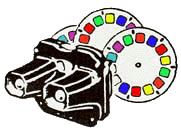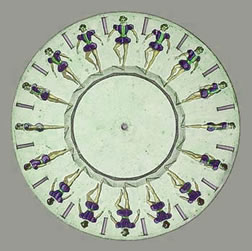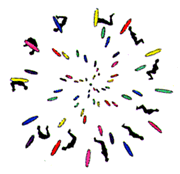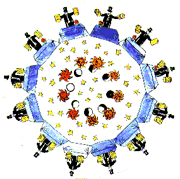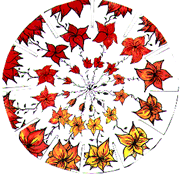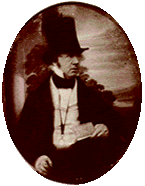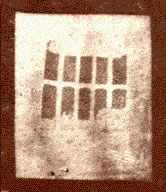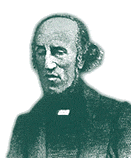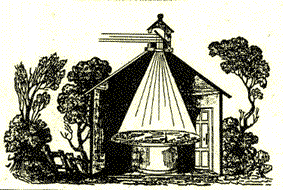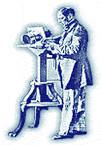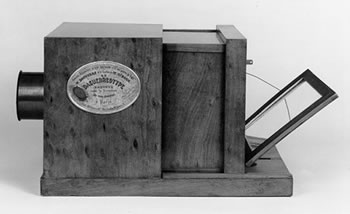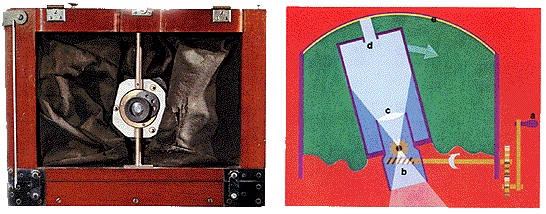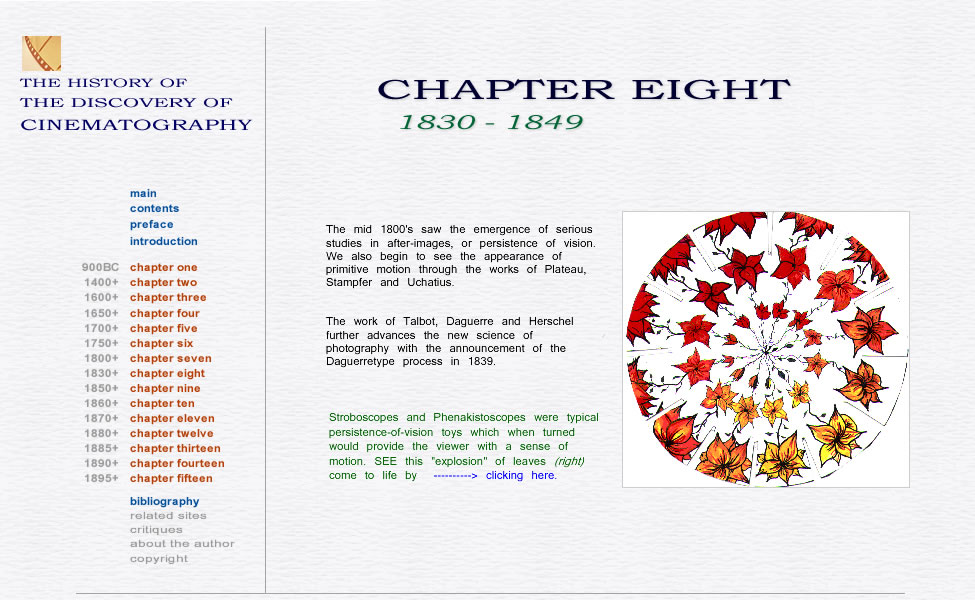 |
| |
|
|
|
| |
|
|
|
| |
1831
(Sir) DAVID BREWSTER (1781 - 1868) |
|
|
| |
Brewster wrote his Treatise
On Optics suggesting the ground glass plate could be replaced
by a plate that had ‚€œa thin film of dried skim
milk‚€Ě when he said . . . . .‚€œI have
found that a peculiarly effect is given to the images formed in the camera
obscura, when they are received upon the silvered back of a looking glass,
smoothed by grinding it with a flat soft bone. In the portable camera
obscura, I find that a film of skimmed milk, dried upon a plate of glass,
is superior to ground glass for the reception of images.‚€Ě
He said the portable camera obscura was a ‚€œuseful
invention‚€Ě which ‚€œdelights every
person‚€Ě. |
|
| |
|
|
|
| |
|
|
|
| |
1831
PETER MARK ROGET - (1779 - 1869) |
|
|
| |
Some reports claim the
Phenakistiscope to be the invention of Roget. We believe
this to be erroneous in that no facts or proof have been offered in any
documentation we have seen to substantiate this. Multiple spellings of
the word also appear from commentary to commentary; Phenakistoscope,
Phenakistascope and Phenakistiscope
which we believe is the correct spelling. An excellent compilation of
these instruments and other inventors, inventions and subjects relating
to cinematography can be seen at Russell Naughton's website Adventures
In Cybersound. |
|
| |
|
|
|
| |
|
|
| |
 |
1832
(Sir) CHARLES WHEATSTONE (1802 - 1875)
Wheatstone
had been working on his idea of a projector-type system that would
present photographs stereoscopically but without any form of movement.
This year he commissions an optical maker in London to construct
two of these devices. One will use reflecting mirrors and the other
refracting prisms. He will announce them in 1838. |
| This
stereo viewer or Stereopticon by Charles Wheatstone
(above left) was one of several devices he designed over the
next two decades. The user could handhold the device or place it
on a simple stand. (Drawing Courtesy the Bill
Gamber and Ken Withers Collection). |
|
|
| |
|
|
|
| |
| The
modern grandchild of the Stereopticon is today
known as the Viewmaster. This toy can be attributed
to William Gruber and was first introduced at the New York World's
Fair in 1939. It is based on Wheatstone's invention. Three-dimensional
Kodachrome images are used and it can still be purchased at many
department stores throughout the world. |
|
| |
The Fisher-Price
Viewmaster
|
|
|
| |
|
|
| |
|
|
|
| |
1832
JOSEPH ANTOINE FERDINAND PLATEAU (1801 - 1883)
Plateau
constructs what he called a ‚€˜Phenakistoscope‚€™ (he
later named it a Fantoscope [not to be confused with Robertson‚€™s
Phantoscope which has been written as Fantoscope]). The contrivance
consisted of a series of drawings or painted pictures of figures
in steps of motion. It had two disks with the inner disk holding
the pictures in order on the rim, and the outside disk which the
viewer (one at a time) looked through. The outer disks had blackened
slits to ensure a constant clear frame and to shield unwanted light
off the picture once seen. Both turned on the identical axis. When
turned together the impression of motion was achieved. By 1832 Plateau
was slowing going blind, the mistake of having looked at the sun
for more than a second (suggested to have been 20 seconds), in 1829.
Plateau was completely blind by 1843.
Plateau's
Phenakistoscope required disks (right) with
14 to 16 images, all showing the progression of movement in successive
order. When turned in the device, the subject would appear to dance.
The disk provided a one second glimpse into the future of cinematography,
slowly advancing the discovery that much further.
|
|
|
|
| |
|
|
|
| |
|
|
|
|
|
|
|
| |
|
|
| |
1832
SIMON RITTER VON STAMPFER (1792 - 1864)
It
is not known whether Stampfer (of Vienna) knew Plateau or of his
work. Stampfer would build his ‚€˜Stroboscope‚€™ this
year with almost exact dimensions as that of Plateau. The Stroboscope
and Phenakistoscope were so similar in construction,
operation, looks and achievement, that they have oft times been
mistaken as the other, by non historians of the craft without a
careful look see. Stampfer also developed something he called a
Magic Drum which he fashioned around the Zoetrope. |
| |
|
|
| The
disk presentations of Stampfer and Plateau were very similar that
few knew the difference at the time. The fundamental understanding
of how these disks appeared to move is based on the fact that an
image remains on our retina (back of the eye) for approximately
1/14 of a second. This is known as 'persistence of vision',
and is easily seen by viewing a disk, Zoetrope
presentation or Thaumatrope. |
|
|
| |
|
|
| |
|
|
|
| |
|
|
|
| |
1833
JOSEPH ANTOINE FERDINAND PLATEAU (1801 - 1883) |
|
|
| |
Finishes his current studies
on persistence of vision and submits a paper on the magic disks that he
used in the Phenakistoscope. |
|
|
|
|
|
| |
|
|
|
| |
1834
BARON FRANZ VON UCHATIUS (1811 - 1881) |
|
|
| |
Do primitive motion pictures
pre-date primitive photography? Notwithstanding the earliest work of Niepce
(1826), the Daguerrean process was announced to the world in 1839. However,
the early work of Uchatius would make us wonder. Uchatius was fascinated
with the possibility of projecting actual motion. It is documented that
he lined up several magic lanterns each containing a single sequential
image and pointed them each at the same point on a wall. He then took
a candle and moving from one to the other, attempted to illustrate sequence
motion. In theory this plan sounds plausible however, one wonders how
quickly he had to move between lanterns, and did the air current blow
the flame out?, or was the flame brilliant enough?
Ceram wisely suggests that he probably used a torch, however we still
wonder at the ability to carry even a torch and move rapidly behind a
series of lanterns (12-16 minimum?) in such a manner and speed as to illuminate
effectively and at length, then to see enough of the image for any persistence
of vision to take effect. And of course without persistence of vision,
we have no appearance of motion. No documentation has been found that
suggests Uchatius had assistance with this endeavor. |
|
| |
|
|
|
| |
|
|
|
| |
1834
WILLIAM GEORGE HORNER (1786 - 1837) |
|
|
| |
Having also studied the
persistence of vision phenomenon, this physicist presents a paper to his
colleagues on his Daedaleum (it was renamed Zoetrope
in 1867 by William Lincoln). The Zoetrope or Daedelum
was a horizontally rotating drum ( about 12 inches in diameter) which
held pictures of different sorts on the inner rim. These pictures showed
forms in successive stages of forward motion. On the outer rim were equally
spaced slits which the viewer looked through. As the drum is spun at speeds
reaching 14 frames per seconds, the figures appear to perform natural
movements. Horner will publish a full description of his machine in the
Philosophical Magazine. The word Zoetrope
is derived from the Greek, as 'wheel of life'.
The word Daedaleum is interpreted as 'wheel of the
devil'. Horner can also be remembered for the effects seen in the
Diorama. |
|
| |
|
|
|
| |
|
|
|
| |
|
|
| |
|
1835
WILLIAM HENRY FOX TALBOT (1800 - 1877)
This
Englishman made a photograph negative on paper known as Photograms,
within a camera obscura. This work of Talbot‚€™s followed closely
in the footsteps of the works of Wedgewood, Scheele and Schulze.
The frame was one inch square and was of a window in his home known
as Lacock Abbey. Talbot was vacationing in Europe, using the camera
obscura when his thoughts drifted back, towards his work . . . .
"It was during these thoughts that the idea occurred to me - how
charming it would be if it were possible to cause these natural
images to imprint themselves durably and remain fixed upon the paper."
He took those ideas with him back home, and in August of 1835 Talbot
produced a photonegative on paper which is extant. It resides in
the Science Museum at the NMPFT Bradford, U.K. |
W.
H. F. Talbot |
|
|
|
| |
|
|
|
| |
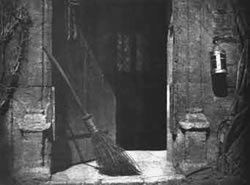 |
Henry
Fox Talbot's work, in particular between 1844 and 1860, was
instrumental in advancing the process of photography.
One of his discoveries
was the unique property of potassium dichromate and how it would
harden colloidal gelatine in correct ratio according to how
much light was exposed.
Talbot had made many
experiments, as had all pioneers of photography.
An early calotype by Talbot, c. 1835 (left)
|
|
|
|
| |
|
|
| |
The one that paid off
for him was accomplished late in the year 1835 at his home in England.
The photograph to the right is of a window in his home which Talbot took
in a camera obscura. It was a negative on paper and is on display in the
photography collection at The
National Media Museum (formerly the National Museum of Photography,
Film and Television), in Bradford, U.K. |
|
| |
|
|
|
| |
|
|
| |
|
|
|
| |
|
|
|
| |
1835
LOUIS JACQUES MANDE DAGUERRE (1787 - 1851) |
|
|
| |
Daguerre is able to produce
an image after exposing mercury vapor to a treated silver iodide plate. |
|
| |
|
|
|
| |
|
|
|
| |
|
|
| |
1836
JOSEPH ANTOINE FERDINAND PLATEAU (1801 - 1883)
Plateau stated the law of the ‚€˜Stroboscopic Effect‚€™.
The law stated in effect; "If within one
second, a series of images (14-16) showing successive movement can
be seen with the eye, and if these pictures are shown in succession,
the laggard sense of sight causes these pictures to be seen as movement
and not as single pictures." Studying the illusion of
the forward-turning wheel appearing to move backwards,
Plateau designs the Anorthoscope to reverse the
phenomenon when viewed. |
|
| |
Joseph
A.F. Plateau |
|
|
|
|
|
| |
|
|
|
| |
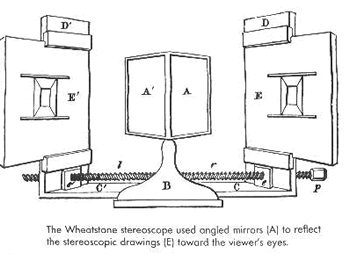 |
1838
(Sir) CHARLES WHEATSTONE (1802 - 1875)
Wheatstone
gives us two Stereoscopes which present a sense
of depth, but no movement. The viewer looked at two images separately
through each eye at the same time. Just like looking through a pair
of binoculars with the subject fusing as one. Mirrors especially
located in the one machine help provide the view, while in the other
design refracting prisms were found. Wheatstone reported to the
Royal Society on the phenomenon of ‚€˜binocular vision‚€™.
The
Wheatstone Stereoscope (left) was first
patented in 1838 and is believed to be the first. It provided a
three-dimensional view. Prior to photography becoming a common practise,
drawings were used. This device was commonly known as a reflecting
stereoscope. (Drawing Courtesy
the Bill Gamber and Ken Withers Collection). |
| |
|
|
|
| |
|
|
| |
|
|
|
| |
|
|
|
| |
1838
ABBE FRANCOIS NAPOLEON MOIGNO ( - ) |
|
|
| |
Another educational use
of the magic lantern (SEE CHESELDEN 1733)
comes to us by way of Moigno. He uses the lantern to examine and illustrate
the reactions to certain chemicals. |
|
| |
|
|
|
| |
|
|
|
| |
|
|
| |
1839
A typical outdoor room camera
obscura is shown in the inaugural edition of the new Magazine of
Science this year. It in fact appeared on the front cover and was
described as ‚€˜a favourite amusement to
view it‚€™s varied and animating pictures.‚€™The article
described further how the camera obscura could be used to form images
and how different lenses could be used in place of others. The writer
concluded that the camera room "is
of such simple construction as to be easily understood, and represents
the objects subjected to it with so unerring a fidelity, and in
all their vivid colours . . . . . or it may be made still more easily
in that form usually called a Portable Camera, a description of
which will appear in our next number." In the next
issue, the magazine made mention of Talbot and Daguerre and their
"newly discovered and important process
of Photogenic Drawing." |
|
| To the right
we see the rendering by the newly established Magazine
of Science in 1839. This camera obscura was depicted
on the front cover and celebrated the new process of Photogenic
Drawing, which was the natural phenomenon of the camera
obscura, made permanent. The article accompanying the picture gave
'co-' and equal credit to Talbot and Daguerre. |
|
|
| |
|
|
| |
|
|
|
| |
|
|
|
| |
1839
JOHANN HEINRICH VON MADLER ( - ) |
|
|
| |
Madler was a German astronomer
and uses the word photography in a science report he wrote. Sir John Herschel
also begins use of the word in his communication on the subject. |
|
| |
|
|
|
| |
|
|
|
| |
1839
(Sir) JOHN FREDERICK WILLIAM HERSCHEL (1792 - 1871) |
|
|
| |
Herschel meets with Talbot
and shows how sodium thiosulfate can ‚€˜fix‚€™ the image without further blackening.
Herschel reports to the Royal Society this Hypo, as well
as the ways of making copies. As well, one Pastor J. Reade also announces
this year a way to ‚€˜fix‚€™ the image. |
|
| |
|
|
|
| |
|
|
|
| |
1839
SAMUEL F. MORSE ( - ) |
|
|
| |
The inventor of the Telegraph,
Morse is believed to be one of the first to see the Daguerreotype
when he visits Daguerre. |
|
| |
|
|
|
| |
|
|
|
| |
1839
WILLIAM HENRY FOX TALBOT (1800
- 1877) and LOUIS JACQUES MANDE DAGUERRE (1787 - 1851) |
|
| |
Both pronounce to the
world that they have individually and independently, discovered photographic
systems which will fix the image caught in the camera obscura. The Daguerre
Daguerreotype Process receives the wider attention and
prominence and is announced by the Frenchman Francois Arago. Talbot reports
to the Royal Society, his earlier findings. |
|
| |
|
|
|
| |
|
|
|
| |
|
|
| |
1839
HIPPOLYTE BAYARD (1807 - 1887)
Bayard
begins to produce a direct-positive image in the camera. The first
photographic exhibit in the world is arranged and hosted by Bayard
in Paris when he presents thirty direct-positive photographs made
on paper. |
|
|
|
| |
|
|
| |
|
|
| |
|
|
|
| |
|
|
|
| |
1839
LOUIS JACQUES MANDE DAGUERRE (1787 - 1851)
Daguerre, as well as
the estate of the late JOSEPH NICEPHORE NIEPCE (1765-1833) are
awarded pensions for life by the French government.
This was an honorary
pension in light of the work and discoveries of both men, as
well as compensation for the use of their processes (Heliography,
Daguerreotypes or Photography) by all. Just
five days after a patent is granted in England for the Daguerreotype
process, it is provided free to the world.
One of the first Daguerreotype
Cameras (right) commercially manufactured, 1839. |
|
|
|
| |
|
|
|
| |
An early 1840's article
published in the New York Mirror puts into perspective the prevailing
attitude towards this new "refined amusement". The article appeared in
the Fine Arts section and discusses the how to's;
The
Daguerreotype.--We have seen with no
little pleasure the whole process and practice of this new and interesting
art, as exhibited by Mr. Gouraud on the principles of Daguerre at the
Granite Buildings, corner of Chambers Street and Broadway. The process
which is very simple, is minutely explained by Mr. Gouraud, and the time
occupied in obtaining a finished proof is something less than one hour.
The highly polished surface of a metallic plate, composed of copper and
silver, is first covered with diluted nitric acid, the plate is then placed
in a close box over a small vessel of iodine, where it is left ten minutes,
and the colour of the plate, originally that of polished silver, is changed
to a fine yellow; the plate is then placed in the camera obscura, before
the object of which a view is desired, and submitted to the action of
light upon its surface; it remains in this position some ten or fifteen
minutes (the time governed by the strength of the light and heat,) and
is then placed in a close box and submitted to the action of mercury for
a few minutes, when the impression is complete. During the whole process
the greatest care is requisite, not only in keeping the surface of the
plate free from the slightest touch or contact with any object, but also
to keep it from the light. The great obstacle in the way of taking portraits
by the Daguerreotype is the difficulty of keeping the countenance, particularly
the eyes, immovable during the time required for the plate to remain in
the camera obscura -- but it is the expectation of M. Daguerre to bring
the art to such a state of perfection that likenesses may be taken as
suddenly as a mirror will reflect them. To those who have taste and leisure
the Daguerreotype will afford a new source of refined amusement; with
the necessary apparatus, a knowledge of the process may be acquired in
a few hours. Those who have not time to study the art themselves should
not fail to attend Mr. Gouraud's interesting lectures and exhibition. |
|
| |
|
- The New York Mirror, February
15th 1840 |
|
| |
|
|
|
| |
|
|
| |
|
|
|
| |
|
|
|
| |
1840's
HENRY LANGDON CHILDE (1792 - 1874) |
|
|
| |
Child attempted the ‚€˜Dissolving
View‚€™ by placing different sources of light behind various painted
glass plates. By diminishing the light as one scene was changed to the
other, Child was able to project a sort of animation however audiences
were not confused as to the lack of true motion. Dissolving Views
were introduced by Childe at the Royal Polytechnic Institution in London.
Traditionally a single lens instrument, the magic lantern became biunial
and triunial as a result of the dissolving view. This allowed the operator
to 'dissolve' one lantern view into another, providing not only an entertaining
story, but also the thought of motion or movement as the story unfolded.
In today's cinema we see the fading from one scene to another scene, or
fade from one shot to another as the great-grandchild of the Dissolving
View. |
|
| |
|
|
|
| |
|
|
|
| |
1842
(Sir) JOHN FREDERICK WILLIAM HERSCHEL (1792 - 1871 |
|
|
| |
Herschel comes up with
a process known as the Cyanotype. It required ferrocyanate
of potassium and allowed for inexpensive but permanent prints. |
|
| |
|
|
|
| |
|
|
|
| |
1844
ROBERT HUNT (1897 - 1887) |
|
|
| |
Hunt gave us a ferrous
sulphite paper negative in 1844 known as an Energiatype. |
|
| |
|
|
|
| |
|
|
|
| |
|
|
| |
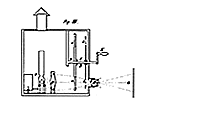 |
1845-1846
BARON FRANZ VON UCHATIUS (1811 - 1881)
Uchatius'
next attempt at recreating motion was more technologically advanced
than his first. The original version of his Lantern Wheel
of Light is built using an oil lamp replacing the candle.
This device contained a glass disk with an opaque shutter. The thin-slitted
shutter however did not allow for a strong throw. This particular
invention was created at the request of a commanding officer that
wanted his troops to be trained using a 'teaching aid'. Uchatius
was a lieutenant in the Austrian forces. |
| Uchatius'
Lantern Wheel of Light of 1845 (left). Using a
kerosene lamp to replace his original candle, Uchatius built this
with a glass disk full of sequence drawings (12) , two lenses and
a crank. When turned, the disk would revolve, as did the images
thereby throwing a series of pictures on the wall and the subsequent
'motion' with it. These images however were cast upon the screen
at approximately six inches square and were therefore too small
to be effective. Uchatius would work on perfecting this device and
in 1853 had an improved version. (Diagram Courtesy Adventures
In Cybersound) |
|
|
| |
|
|
|
| |
|
|
|
| |
|
|
| |
|
|
|
| |
|
|
|
| |
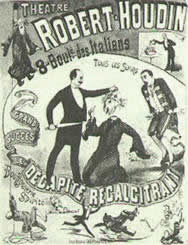 |
1845
JEAN-EUGENE (ROBERT) HOUDIN (1805 - 1871)
The
French born Houdin must be mentioned if not for the marvelous work
he did in the art of sleight-of-hand, than for his contribution
to the art of automata. As magic is not the theme of our study,
we must suggest that Houdin (of whom the great magician of the 20th
century, Harry Houdini, took his name) added to the dream of motion
through his abilities not only to repair but also design and build
his own automatons, namely, his famous writing and drawing figure
of the mid 19th century.
However as a great magician of his time, Houdin was not conscious
we believe, of contributing to motion recreation outright. We do
believe however, that as automatons present a realistic attempt
in the illusion of motion, they can be remembered as significant
entries in the history. Houdin presented his first private and public
performances this year which included the figure, which he later
sold to the American circus entertainer, Phineas T. Barnum. Houdin
also created an automaton known as the Vaulting Trapeze. |
|
|
| |
|
|
| |
|
|
| |
|
|
| |
|
|
| |
|
|
| |
1845 - JOHANN MULLER
( - ) |
|
| |
This physicist and scientist
begins to use the Fantoscope and its use of disks, to
study wave motion in light. |
|
| |
|
|
| |
|
|
| |
|
|
| |
|
|
| |
|
|
| |
1845
FRIEDRICH VON MARTEN ( - )
Invents
and introduces a Panoramic Camera which takes panoramic
photographs 5 inches by 4 3/4, on a curved plate.
Von Martens
camera was the first to use a swing lens and curved film plate.
On the far right image - hand crank (a) turned gear (b) which swiveled
lens (c) slit (d) projects the image onto film (e) |
|
| The
Von Marten camera is considered a true panoramic camera. The photo
does not need to be cropped to get a panoramic result. The view
is exposed onto film through a narrow slit and a continuous image
is built up as the slit is moved across the film. (Image
Courtesy Clayton Tume - Bigshotz Panorama Photography) |
|
|
| |
|
|
|
| |
|
|
| |
|
|
|
| |
|
|
|
| |
1847
ABEL NIEPCE DE ST. VICTOR ( - ) |
|
|
| |
A Frenchman, Victor announces
a process of making albumen negatives on glass. The albumen process consisted
of glass plates being used in the place of paper. It was an extract from
the white of eggs added with other light-sensitive agents. In 1850, Albumen
prints will be made by Blanquart-Evrard. |
|
| |
|
|
|
| |
|
|
|
| |
|
|
| |
1848
CHARLES FONTAYNE (1814 - 1901) and WILLIAM S. PORTER (1822 - 1889)
In September of this year
Fontayne and Porter took a Panoramic photograph
of the Cincinnati waterfront consisting of eight plate Daguerreotypes.
The picture was at the time, titled "Daguerreotype View
of Cincinnati Taken from Newport, Ky." but is today known
as The Cincinnati Panorama. Fontayne and Porter
placed their camera on a roof, on the Kentucky side of the Ohio
River. The Panorama is part of the collection of
the Public Library of Cincinnati and Hamilton County, Cincinnati,
Ohio. |
| |
|
|
This
Daguerreotype Panorama of the Cincinnati shoreline of the Ohio River
was taken using eight individual whole-plates and is in the possession
of the Public Library of Cincinnati and Hamilton County. It was
taken in 1848. (Thanks
to John R.Reusing, Development Director, Public Library of Cincinnati
and Hamilton County)
View
A Large Format Of This Digitized Daguerreotype Here. |
|
|
| |
View
This Cincinnati Waterfront Panorama Daguerreotype At The University of
Rochester Here . Zoom in or out, plate by plate. |
|
| |
View
How This 1848 Daguerreotype Panorama Brings Middle America's Past to Life
From Wired Magazine Here. Learn how the panorama was restored and
much more. |
|
| |
Thanks
to John Reusing. |
|
| |
|
|
| |
|
|
| |
|
|
|
| |
|
|
|
| |
1848
E. M. CLARKE ( - ) |
|
|
| |
Publishes a book in London
on the use of the oxy-hydrogen blowlamp (invented by Robert Hare in
1802) and its use in educational presentations. He calls it ‚€˜Directions
For Using The Philosophical Apparatus In Private Research And Public Exhibition‚€™. |
|
| |
|
|
|
| |
|
|
|
| |
1848
JOSEPH ANTOINE FERDINAND PLATEAU (1801 - 1883) |
|
|
| |
Suggests the use of photographs
in the use of motion study analysis, in place of the still-used drawings. |
|
| |
|
|
|
| |
|
|
|
| |
1849
FIRST PHOTOGRAPHIC HISTORY |
|
|
| |
The first "history" written
on the photographic process and discovery is published this year in New
York. |
|
| |
|
|
|
| |
|
|
|
| |
1849
(Sir) DAVID BREWSTER (1781 - 1868) |
|
|
| |
Designs a Stereoscopic
Camera with binocular lenses for photographing stereoscopic pictures.
Until now, all Stereoscopic Photographs had been taken
using two successive exposures using a single lens. |
|
| |
|
|
|
| |
|
|
|
| |
|
|
|
| |
|
|
|
| |
|
|
|
| |
|
|
|
| |
|
|
|

|
| |



